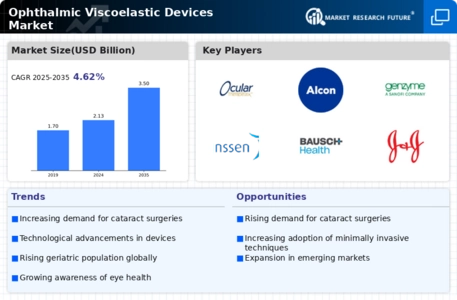Market Growth Projections
The Global Ophthalmic Viscoelastic Devices Market Industry is projected to experience robust growth in the coming years. With a market size of 2.13 USD Billion in 2024, it is anticipated to reach 3.5 USD Billion by 2035. This growth trajectory suggests a compound annual growth rate of 4.62% from 2025 to 2035. Various factors contribute to this positive outlook, including technological advancements, increasing surgical procedures, and a growing geriatric population. As the industry evolves, stakeholders are likely to explore new opportunities and innovations, further enhancing the market's potential.
Increase in Geriatric Population
The global increase in the geriatric population is a significant driver for the Global Ophthalmic Viscoelastic Devices Market Industry. Older adults are more susceptible to various eye conditions, including cataracts and age-related macular degeneration, which often require surgical intervention. As the demographic landscape shifts, the demand for surgical procedures utilizing viscoelastic devices is likely to rise. This trend is particularly evident in regions with aging populations, where healthcare systems are adapting to meet the needs of older patients. Consequently, the market is expected to experience sustained growth, reflecting the increasing surgical needs of this demographic.
Regulatory Support and Approvals
Regulatory support and streamlined approval processes for ophthalmic devices are fostering growth in the Global Ophthalmic Viscoelastic Devices Market Industry. Governments and regulatory bodies are increasingly recognizing the importance of these devices in enhancing surgical outcomes. Initiatives aimed at expediting the approval of innovative products are encouraging manufacturers to invest in new technologies. This supportive regulatory environment is likely to lead to a wider range of products entering the market, thereby increasing competition and driving down costs. As a result, the market is expected to expand, with a projected value of 2.13 USD Billion in 2024, indicating a positive outlook for the industry.
Rising Prevalence of Eye Disorders
The increasing incidence of eye disorders globally drives the demand for ophthalmic viscoelastic devices. Conditions such as cataracts and glaucoma are becoming more prevalent, necessitating surgical interventions. The Global Ophthalmic Viscoelastic Devices Market Industry is poised to benefit from this trend, as more patients require procedures that utilize these devices. In 2024, the market is projected to reach 2.13 USD Billion, reflecting the growing need for effective surgical solutions. As the population ages, the demand for cataract surgeries is expected to rise, further propelling the market forward. This trend indicates a robust growth trajectory for the industry.
Growing Awareness and Accessibility of Eye Care
The rising awareness regarding eye health and the accessibility of eye care services are pivotal factors driving the Global Ophthalmic Viscoelastic Devices Market Industry. Public health campaigns and educational initiatives have led to increased knowledge about eye disorders and the importance of regular check-ups. This heightened awareness encourages individuals to seek surgical interventions when necessary, thereby increasing the demand for ophthalmic viscoelastic devices. Moreover, the expansion of healthcare infrastructure in developing regions is making eye care services more accessible. As a result, the market is expected to witness substantial growth, with projections indicating a market size of 3.5 USD Billion by 2035.
Technological Advancements in Surgical Techniques
Innovations in surgical techniques and technologies are significantly impacting the Global Ophthalmic Viscoelastic Devices Market Industry. The introduction of minimally invasive procedures has enhanced the efficiency and safety of eye surgeries, leading to increased adoption of viscoelastic devices. For instance, advancements in phacoemulsification techniques have improved surgical outcomes, thereby boosting the demand for these devices. As the industry evolves, manufacturers are likely to invest in research and development to create more effective products. This focus on innovation is expected to contribute to a compound annual growth rate of 4.62% from 2025 to 2035, underscoring the potential for growth in the market.


















Leave a Comment